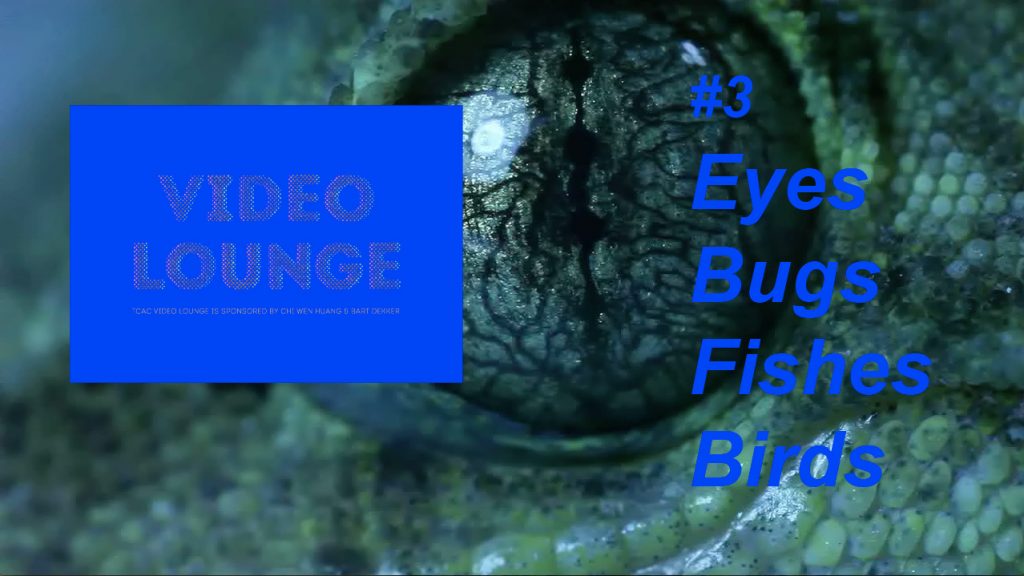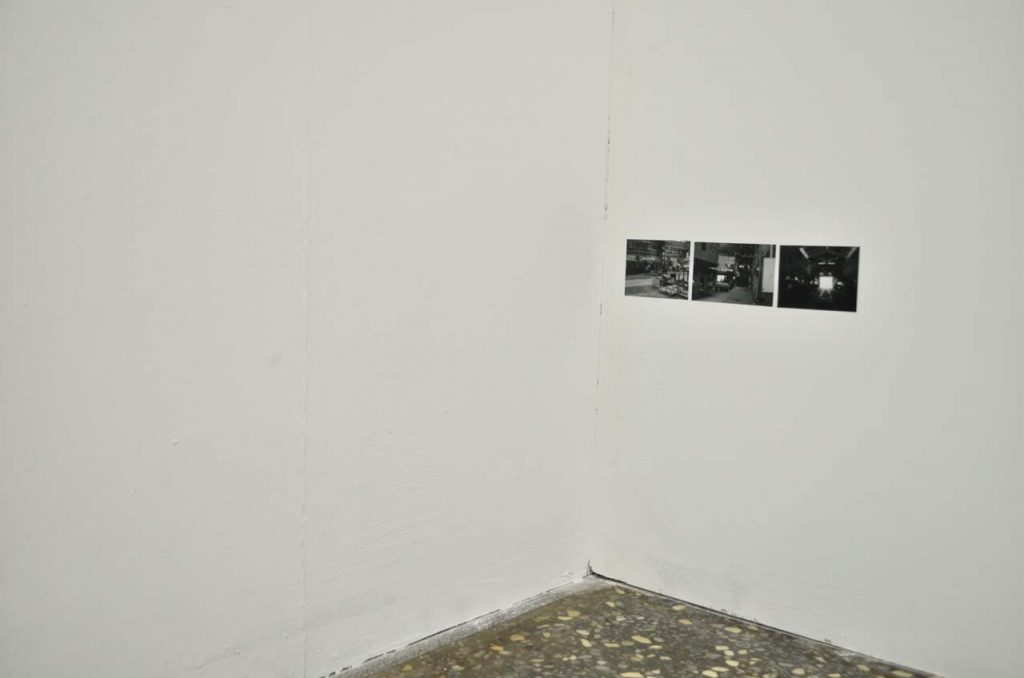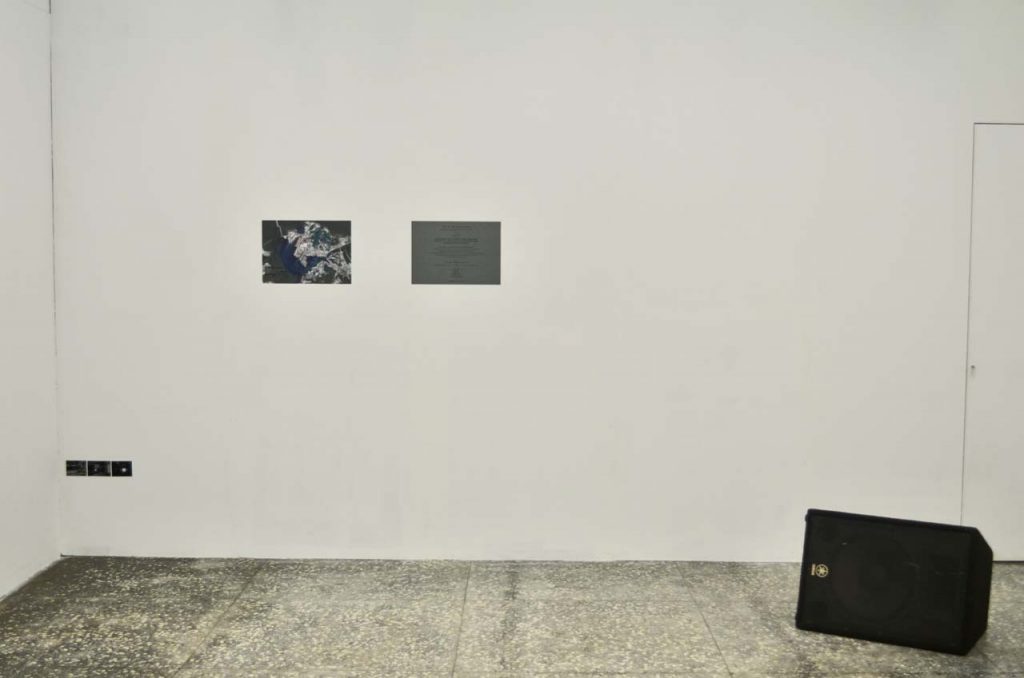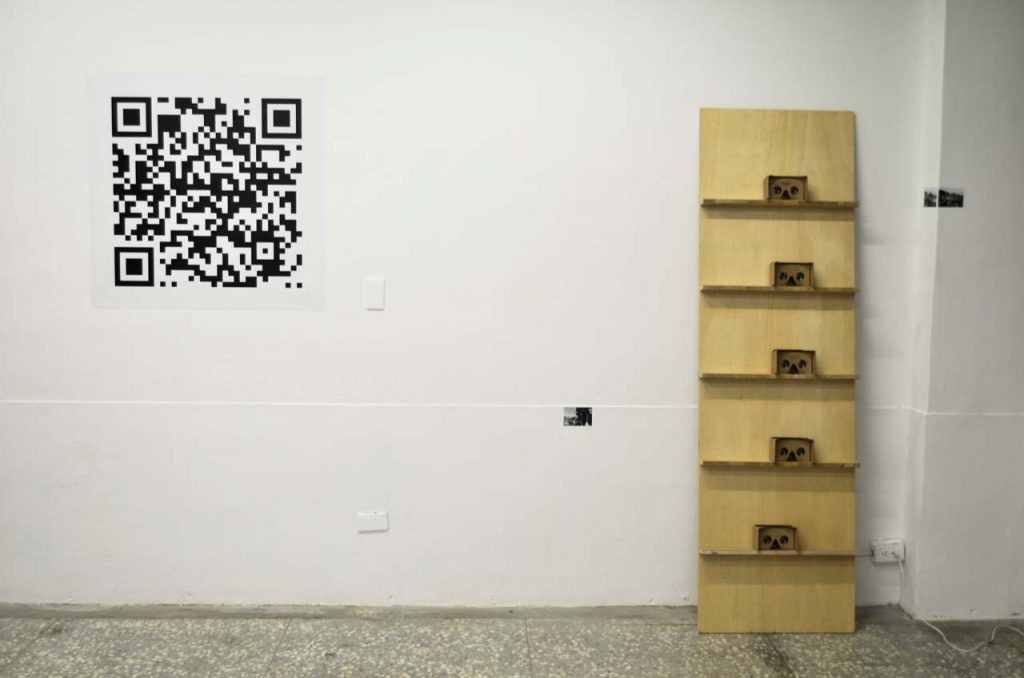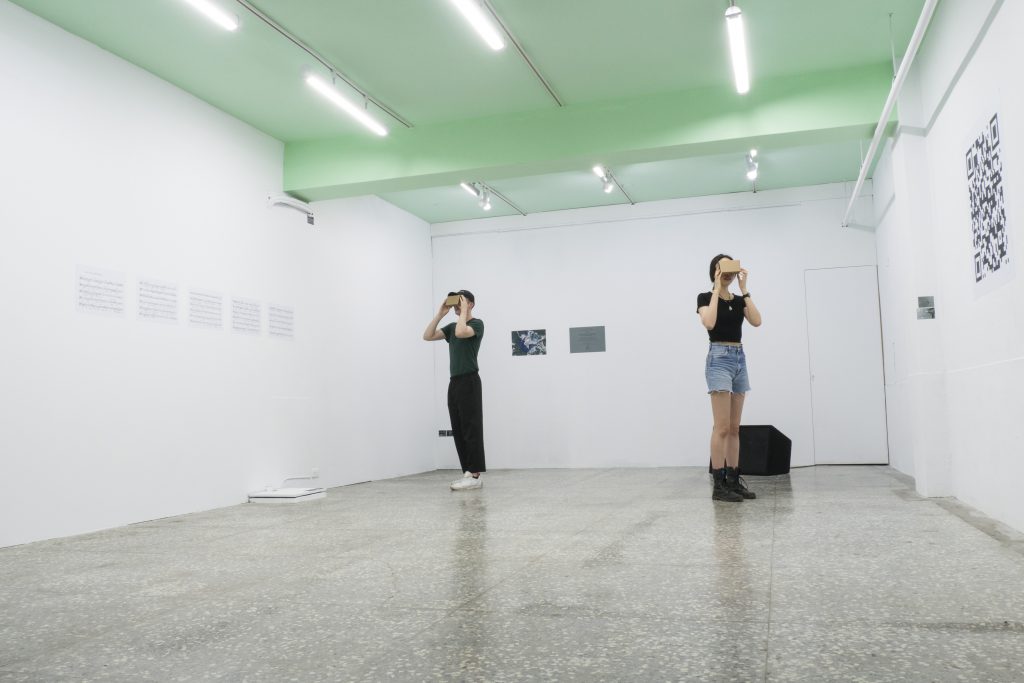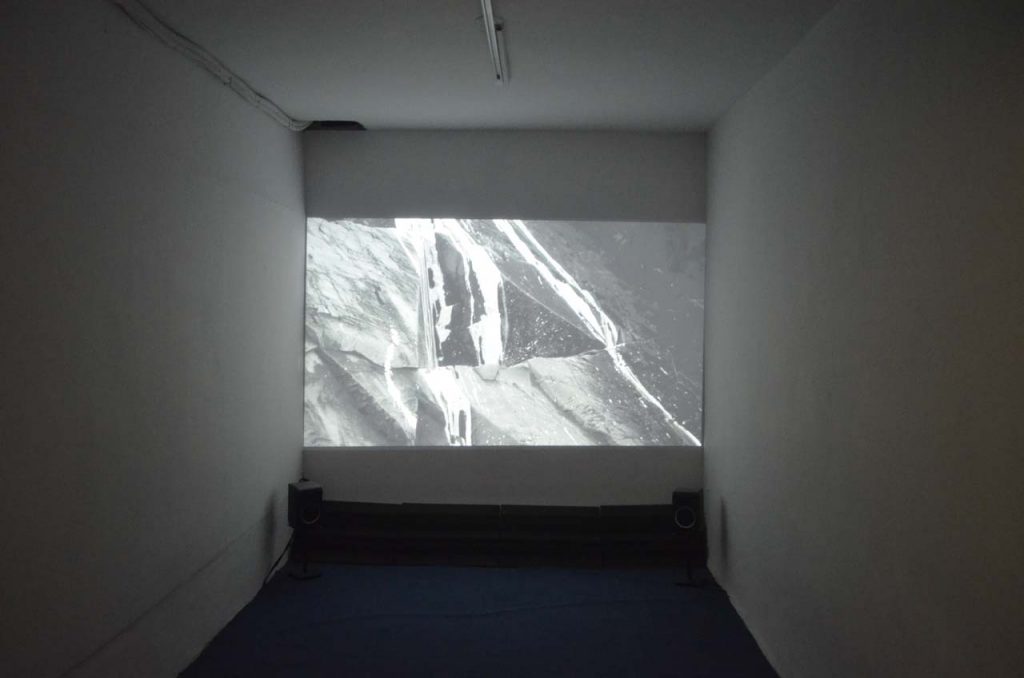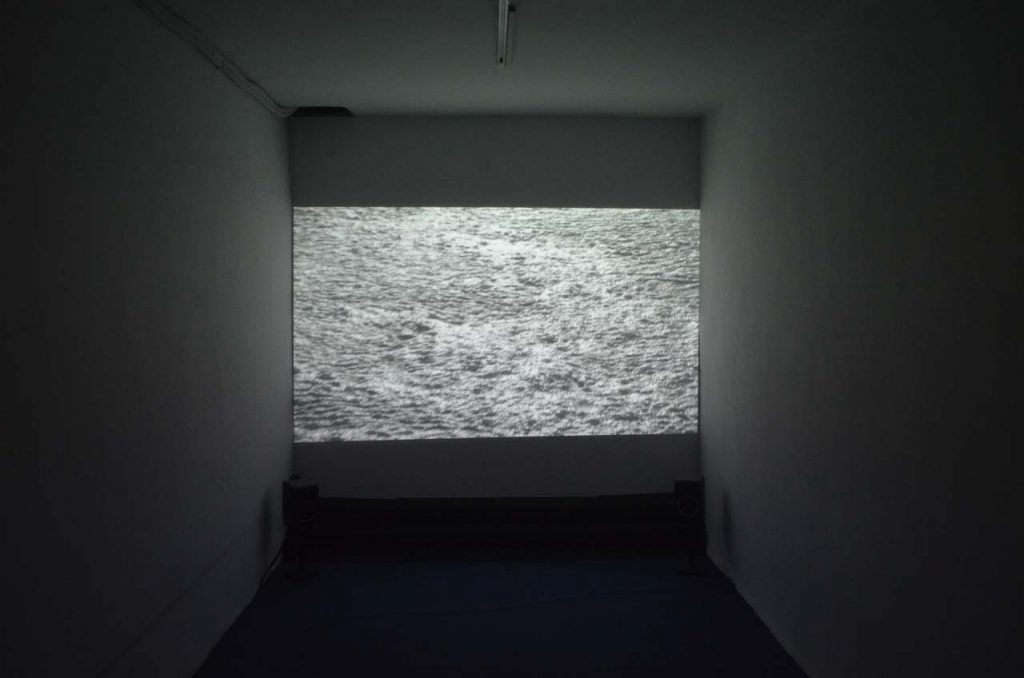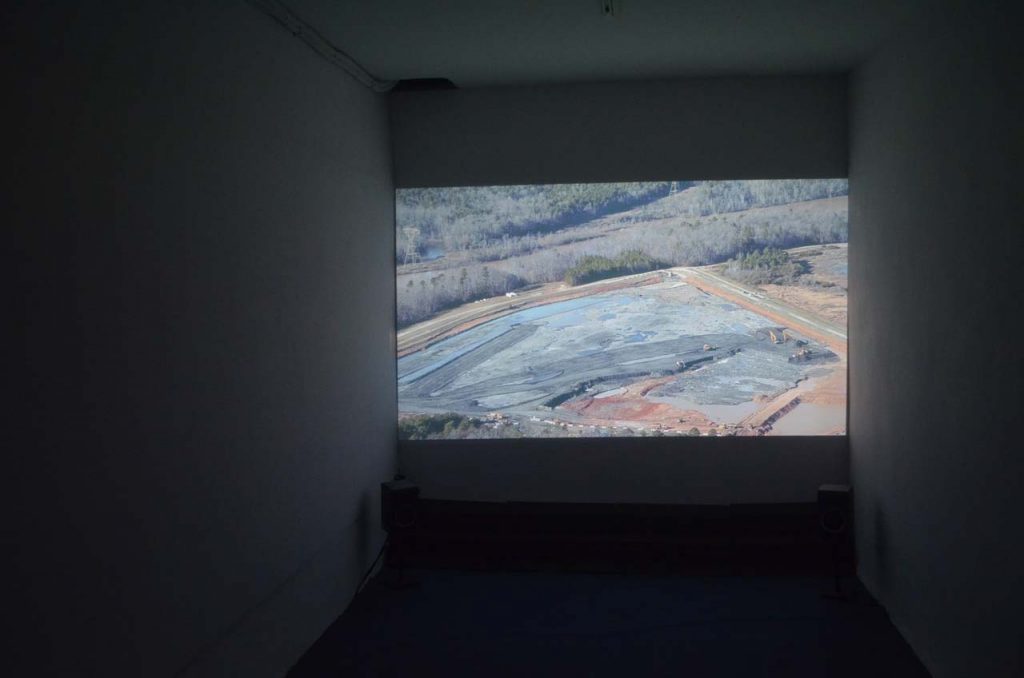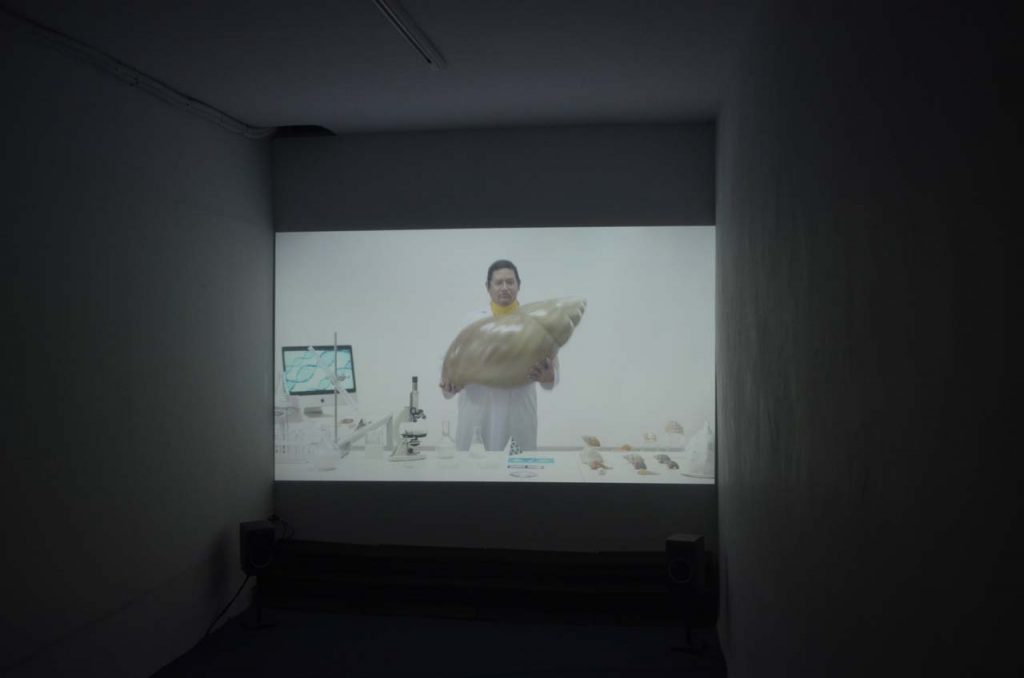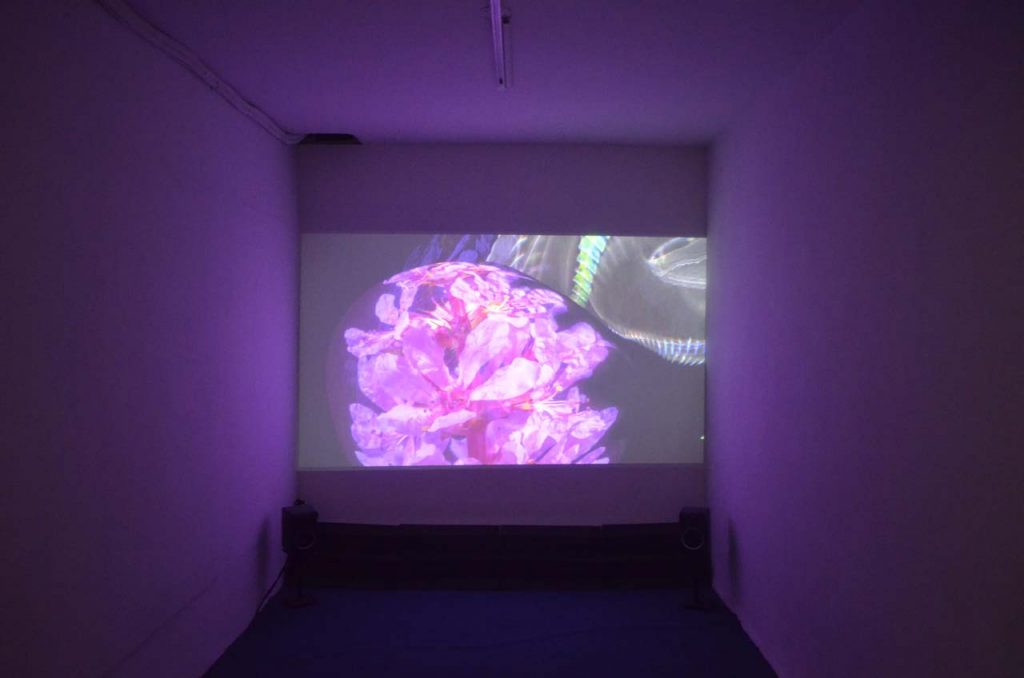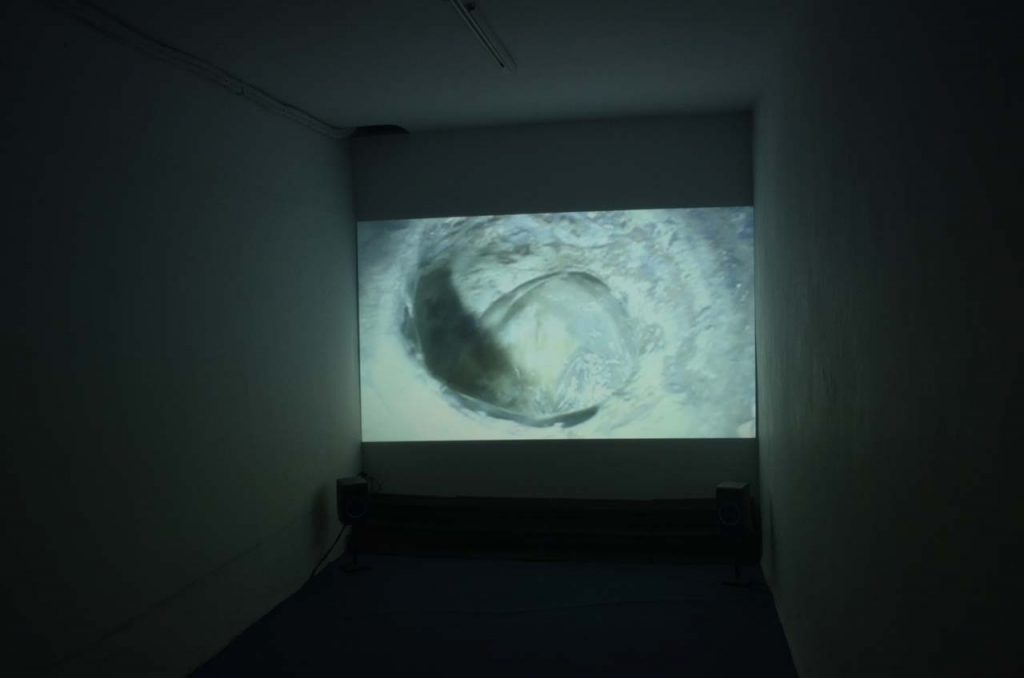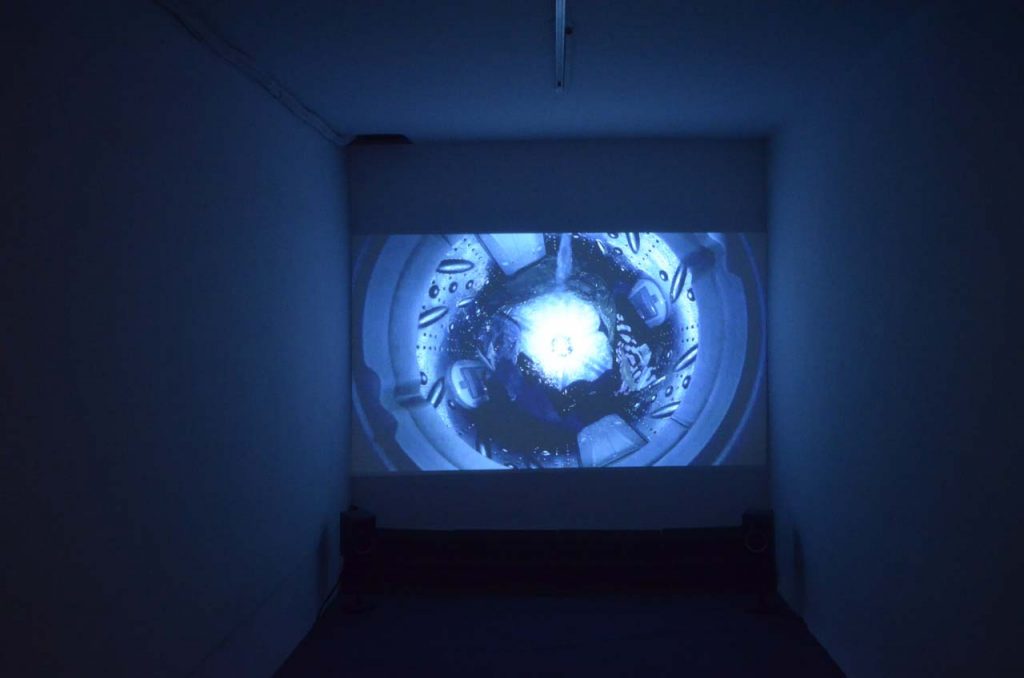(For English, Please Scroll Down)
2018 錄像廳第三季《眼看蟲魚鳥》
日期:11/16 – 25 1 – 7pm. (週一不開放)
地點:台北當代藝術中心(台北市大同區保安街49巷11號1樓)
在錄像廳第二季《刪除物件歷史》的最後,我們詰問人類自身是否也成為棲居在自然與技術的複合結構中的數碼物。自然與技術並非相互對立,二者之間的動態交纏深深影響當代的視覺經驗。技術的演進製造更多類型的觀看儀器,讓觀看的方式與角度得以被拓展。而自然也在各種影像呈現中被主體化。影像化的自然,是否也輕易地塑造人類做為一個物種的命運共同體想像,成為一種不得不臣服的意識形態?第三季《眼看蟲魚鳥》的作品,觀看與被觀看都不再以人作為觀看的主體與視線的中心。想像在閉錄電視、無人機、科學儀器記錄下的影像中,是什麼樣的平行的敘事得以被述說。在這個時間軸中,地理景觀是否有可能不再成為資源的象徵,被資本主義收編?人與非人是否有可能視線齊平,攜手並進?如果觀看是作為擁有同理心的第一步,或許人類該先試著像鳥一樣觀看,才有可能走向像蜥蜴ㄧ樣感受的未來。
關於作品:
// 地表
張博傑,《早安、午安、晚安,再會、港都、行船人》,8:35,2018.
《早安、午安、晚安,再會、港都、行船人》原本是一個位於基隆正濱漁港景觀平臺的限地製作,作品中的音樂改編於五六零年代的流行歌曲。港口是資本主義將自然水文納入體系的最佳見證,一個個被吊起的貨櫃們看到了什麼?
// 洞穴
Tejal Shah,《某種自然》,單頻道錄像,6:36,2013-2014.
波斯詩人 Rumi 寫下:「旋轉地必來自中心。」《某種自然》利用黑白影像重新凝視自然,河流、海洋、林木在神秘又詭譎的氣氛中被詩意地呈現,但誰才是那個中心?
Chulayarnnon Siriphol,《金色螺旋》,單頻道錄像,18:00,2018.
自然界中的螺旋結構在神話、建築結構、地質學中現身,編織出一則荒謬的現世寓言。人類對美與青春的迷戀,對科學的信仰是不是一種可笑的執著?
Rob Carter,《卡托巴》,單頻道錄像,5:56,2017.
卡托巴位於美國北卡羅來納州,地名起源自當地原住民族名,而當地的地貌就如同該名詞所象徵的意義一樣,隨著時間被改變、被遺忘、消失。
Eva Papamargariti, 《脆弱的棲息者》,單頻道錄像,13:12, 2017.
藝術家 Papamargariti 利用數位影像與現成影片創造一個人機混合生物、人造自然共同存在的世界。在這裡,二元對立被拆解,一切都是流動的。
吳其育,《蟑螂屋-洞的奧祕》,單頻道錄像,6:04,2011. *
在《蟑螂屋-洞的奧祕》中,鏡頭觸及平常我們視線未及之處。人類棲居之處,也是其他生物的「自然」。
*「TCAC Video Lounge X 鳳甲美術館TIVA錄像資料庫」選映。
** 洞穴內影片放映總長度約為50分鐘,整點循環播放。
關於藝術家
張博傑, http://www.pochiehchang.com/
1986年生,2012年獲實踐大學建築系學士學位,2016獲台北藝術大學新媒體藝術系碩士學位,目前生活、工作於台北。張博傑的作品多以數位生活工具使用經驗為發想,與參與者共寫敘事日常。在這樣創作過程中,他探討人與人之間微妙的牽連、不可見的交會、個人到群體的生命經驗。他善於提及數位生活所控制的身體,如作品「地圖詩歌系列」描述重度遵守數位導航路線的徒步玩家,冒險於城市之中,和誤用數位搜尋工具所創造出來的藝術語言,如作品「眾人詩」,蒐集上百句熱門關鍵字,重組成大眾共同書寫的紙本詩選。近期展覽包括個展:《藝‧數之間-解開藝術的密碼 》(藝術銀行,2017) 、《後.美獎 》(台北索卡藝術空間,2016)、《致·前線的鄰居》(南海藝廊,2106)、《表象的深度》(覓空間,2015)、《壯遊》(空總創新基地,2014)、《張婌芬》(台灣美術館,2014);獲獎:《台北美術獎/入選》(台北美術館,2014)、《全國美術獎/金牌獎》(台灣美術館,2013,)、《新媒體藝術卓越獎》(關渡美術館,2013)。
Tejal Shah, http://tejalshah.in/
Tejal Shah(1979年生於印度Bhilai,現居印度果阿)畢業於墨爾本皇家墨爾本理工大學,獲得攝影學學士學位,在芝加哥藝術學院擔任交換生一年,也曾經在另一個夏天試圖獲得紐約州北部的巴德學院MFA。他╱她的實踐包含任何事情與一切事情,包括視頻、攝影、表演、食物、繪畫、聲音、裝置和永續的生活方式。在探究一切時,他╱她常常無意識地表現出“不適當╱不適合的他者” – 一個你無法引用的人和一個不合適的人。體驗他╱她的作品需要進入充滿事實、小說、詩歌和神話的奇異世界,迫使我們層層探究種族間、生態、性別、後色情、性和意識之間的關係。他╱她最近作為一名生態戀者,他們認為自己是“某種從事某種自然的藝術家”。
Chulayarnnon Siriphol, http://www.chulayarnnon.com
Chulayarnnon Siriphol出生於1986年。他的實踐探索創造動態影像的各種可能性,使用錄像作為媒介,身兼電影製作人與視覺藝術家。他的作品包括短片、實驗電影、紀錄片和錄像裝置。作品敘事挖掘個人記憶和社會記憶,紀錄片和小說,現實和超自然之間的模糊地帶,並且透過諷刺、奇想和獨特的幽默感來質疑對於美德和理想的信念。
他的短片《消失的海平面》獲得了2014年新加坡國際電影節的特別獎。他的其他短片已經在許多電影節上放映,例如荷蘭鹿特丹第34屆國際電影節(2005年),日本山形國際紀錄片電影節(2011年),德國漢諾威第11屆國際電影節(2011年), Arkipel:印度尼西亞雅加達國際紀錄片和實驗電影節(2015年)。他的個展包括:Ghost Orb,Eat Me Restaurant,泰國曼谷(2011年),畫作背後,由Hatoyi博士,藝術中心,Silpakorn大學,泰國曼谷(2015),基拉蒂博物館,曼谷城市畫廊策劃,曼谷,泰國(2017年)和群展,第五屆福岡亞洲藝術三年展,日本福岡(2014年),第19屆當代藝術節Sesc_Videobrasil,聖保羅,巴西(2015年),Aún (Still/Yet) – 44SalónNacionalde Artistas ,由Inti Guerrero策劃,Pereira,哥倫比亞(2016),土壤和石頭,靈魂和歌曲,Para Site,香港(2017),神秘多數,The Academy of the Arts of the World,德國科隆(2017年)。他的最新短片《PLANETARIUM》於5月8日至19日在2018年坎城影展特別放映單元首映,為電影《十年泰國》的一部分。本片由四名泰國導演(Apichatpong Weerasethakul,Wisit Sasanatieng,Aditya Assarat和Chulayarnnon Siriphol),探討泰國當今的政治和社會問題。Chulayarnnon Siriphol 目前在曼谷生活和工作。
Rob Carter, https://www.robcarter.net/
Carter 為出生於英國,現居美國的藝術家。他使用攝影、影像動畫和裝置創作。他在牛津大學的拉斯金繪畫與美術學院獲得了藝術學士學位,後來在紐約亨特學院獲得藝術碩士學位。
Carter 的作品在國際展出,包括舊金山 Catherine Clark畫廊(2015年,2018年),紐約 Art In General(2012年),科隆 Galerie Stefan Röpke(2012年),紐約Station Independent Projects(2012與2015年),Galeria Arnésy Ropke(2013年)和羅馬 Fondazione Pastificio Cerere(2008年)。
Carter 也在柏林König Galerie(2017年),奧本大學 Jule Collins Smith美術館(2016年),San Jose ICA(2016年)法國蓬皮杜梅斯中心(2013年),日本廣島市當代藝術博物館展出(2013年),哥本哈根 Traneudstillingen(2013年),芝加哥菲爾德博物館(2012年),費城ICA(2010年)和紐約藝術與設計博物館(2009年)展出。
Eva Papamargariti, http://evapapamargariti.tumblr.com/
Eva Papamargariti(b.1987)來自建築背景,並擁有倫敦皇家藝術學院視覺傳達設計碩士學位(2016年)。她的實踐專注於基時媒體,同時使用印刷材料與雕塑裝置,探索數位空間和物質與非物質現實之間的關係。她同時對創作2d與3d渲染空間和場景感興趣,這些場景基於在數位與實體空間“生態系”的交界之處,並以日常的頻率建立模糊且共時的敘述。
吳其育(b. 1986,台北),作品的基本關懷在於找尋如何在被技術-資本主義摧毀的廢墟中重建人、事物、動物與世界連結的方式。其創作主要以動態影像為主,透過口述歷史與傳說的紀錄進行文本的再製,在逝去的記憶中尋找當代敘事的語言型態,同時也進行裝置、影像裝置與表演等不同類型的合作計畫。
吳其育曾進駐於荷蘭皇家藝術村(Rijksakademie,阿姆斯特丹,2014-2015)。個展:時間91平方米(TKG+ Project,台北,2017)。參與聯展:上海雙年展(上海當代藝術博物館,上海,2018)、穿越正義(台北當代藝術館,台北,2018)、台北雙年展(台北市立美術館,台北,2016)、第二屆CAFAM未來展(中央美術學院美術館, 北京,2015)。參與的影展:北京國際短片聯展(2017)、EXiS Festival,首爾(2017)、Arkipel Festival,雅加達(2016)。
圖片版權:吳其育,《蟑螂屋-洞的奧祕》,單頻道錄像,2011。
2018 Video Lounge Series 3: Eyes, Bugs, Fishes and Birds
Time: 11/16 – 25 1 – 7pm. (Close on Monday)
Venue: TCAC (1 Fl, No.11, Lane 49, Baoan Street, Datong District, 10346 Taipei)
In Video Lounge Series 2 Delete Object History, we questioned ourselves the way to distinguish the difference between human beings and digital objects in the hybrid environments of nature and technology. Nature and technics are not rigid dichotomy. The intertwined dynamics of the two concepts deeply shaped the visual experiences of our times. The revolution of technology led to the invention of various apparatus for seeing and looking as well as of viewing perspectives. Natural landscapes becomes a subject to be seen. The representation of nature in different visual media creates an imagined community of human beings as one specie. Is this an ideology to which we surrender? Works in Series 3 Eyes, Bugs, Fishes and Birds shift the center of the vision from the human beings’ perspective to the Others. What kind of narratives could be found in the images captured by CCTV, drones and scientific equipments? On this parallel timeline, does the natural landscape escape from the fate of being excavated by the capitalism? Could human and non-human perceive from the same standing point and co-exist peacefully? If being able to see is the first step to have empathy, are we prepared for the future when we see from the eyes of bugs, fishes and birds?
//Ground
Po-chieh Chang, Good Morning, Good Afternoon, Good Night, Good Bye, Harbor, Sailor, 8:35, 2018.
Originally a site-specific work at Chen-Pin Fishing Harbor in Keelung, Good Morning, Good Afternoon, Good Night, Good Bye, Harbor, Sailor incorporates music adapted from popular songs in the 50’s and 60’s. Harbor is the locality where the capital system utilizes water resources. What do the containers see from up above?
//Cave
Tejal Shah, Some Kind of Nature, 6:36, 2016.
Some Kind of Nature presents rivers, oceans and forests in black and white images, creating a mystical, uncanny and poetic atmosphere. Persian poet Rumi wrote down that “Whatever circles comes from the center.” We could not stop wondering what and where is the center?
Chulayarnnon Siriphol, Golden Spiral, 18:00, 2018.
In the narrative of Golden Spiral, spiral reveals itself in different realms such as myth, architecture and geology. Our obsession with beauty and youth as well as the belief in science become an absurd allegory.
Rob Carter, Catawba, 5:56, 2017.
Catawba is located in the North Carolina in the U.S. The name originates from the name of the Indigenous tribe in that area. However, the natural landscape is like the meaning of the name, changing, being forgotten and disappearing with time.
Eva Papamargariti, Precarious Inhabitants, 13:12, 2017.
Papamargariti uses digital images and found footages to create a world where human-machine hybridities live in an artificial nature. In this reality, the boundaries are dissolved and everything becomes fluid.
Wu Chi-yu, Cockroach Trap-The Mystery Hole, 6:04, 2011.*
In Cockroach Trap-The Mystery Hole, the camera takes us to the corners and spots where we rarely pay attention to. The living environment we call home is also the nature to many Others.
* Selected from TCAC Video Lounge x Hong-Gah Museum TIVA Video Art Archive.
** Total screening time in the Cave is 50 minutes. Loop in every hour.
About the artists
Po-chieh Chang, http://www.pochiehchang.com/.
Born in 1986, and graduated from the Department of Architecture, Shih-Chien University 2012, MFA in New Media arts, Taipei National University of the Arts Master’s degree,2016, Currently lives and works in Taipei. Po-chieh Chang’s works are inspired by the experience of utilizing digital tools, drafting everyday narratives with participants. Through this process he explores the subtle, unforeseen connections between people, from the individual to the community. The body disciplined by technology is emphasized in his series titled “Map Poetry” which portrays a player depending heavily on navigation technology to explore the city. Miscommunications triggered by search engines form its own artistic language in “Our Poetry” which is a collection of trending phrases coming together to construct poetry of the people.
Recent exhibitions include solo exhibitions: “Between Art and Mathematics: Decoding the Artworks” Art Bank (2017), “ POST – AWARDS” SOKA ART Taipei (2016), “love thy neighbor as thyself ”/ Nanhai Gallery/ Taipei(2016),“ THE DEPTH OF APPEARANCES ”MEME SPACE ,Taipei(2015),“ Grand Tours ” /Air Force Headquarters site / Taipei(2014),“ Chang Shu-feng ”Taiwan Museum of Fine Arts / Taichung(2014). Awards: “2014 Taipei Fine Arts Award/Selected”Taipei Fine Arts Museum、2013 “national art exhibition , roc ” Gold Award / National Taiwan Museum of Fine Arts / Taichung, 2013 “ New Media Art Merit Award ”Merit Award / KdMoFA / Taipei.
Rob Carter, https://www.robcarter.net/
British-born and now US-based, artist Rob Carter uses photography, video animation, and installation. He received his BFA from The Ruskin School of Drawing and Fine Art at Oxford University and later received an MFA in Studio Art from Hunter College in New York.
He has shown his work internationally, with solo exhibitions at Catherine Clark Gallery in San Francisco (2015, 2018), Art In General in New York (2012), Galerie Stefan Röpke in Cologne (2012), Station Independent Projects in New York (2012, 2015), Galeria Arnés y Ropke in Madrid (2013) and Fondazione Pastificio Cerere in Rome (2008).
Carter has also exhibited at König Galerie, Berlin (2017), Jule Collins Smith Museum of Fine Art at Auburn University (2016), ICA in San Jose (2016) Centre Pompidou-Metz in France (2013), Hiroshima City Museum of Contemporary Art in Japan (2013), Traneudstillingen in Copenhagen (2013), The Field Museum in Chicago (2012), ICA in Philadelphia (2010) and Museum of Arts and Design in New York (2009).
Tejal Shah, http://tejalshah.in/
Tejal Shah (b.1979, Bhilai, India; currently lives in Goa, India) graduated with a BA in photography from RMIT, Melbourne, spent a year as an exchange student at The Art Institute of Chicago and another summer trying to get an MFA from Bard College in upstate New York. Their* practice incorporates everything and anything, including video, photography, performance, food, drawing, sound, installation, and modes of sustainable living. Queerying everything, they often unselfconsciously manifest “the inappropriate/d other”–one whom you cannot appropriate and one who is inappropriate. Experiencing their works entails entering alter-curious worlds riddled with fact, fiction, poetry and mythology, that compel us to engage with layered propositions on the relationships between interspecies, ecology, gender, post-porn, sexuality and consciousness. Having recently come out as an ecosexual, they think of themselves as ‘some kind of artist working on some kind of nature’.
Chulayarnnon Siriphol, http://www.chulayarnnon.com
Chulayarnnon Siriphol was born in 1986. He is interested in exploring new possibilities in creating moving images. He is thus working between the role of a filmmaker and an artist, using video as a medium. His works range from short film, experimental film, documentary to video installation which are in-between personal memory and social memory, documentary and fiction, reality and supernatural. Through these pieces, he questions the belief of virtue and ideal through sarcasm, illusions, and his own sense of humor. His short film Vanishing Horizon of the Sea won Special Mention from the 2014 Singapore International Film Festival. His other short films have been screened in many film festivals, for example, The 34th International Film Festival Rotterdam, Netherlands (2005), Yamagata International Documentary Film Festival, Japan (2011), The 11th International Film Festival Hannover, Germany (2011), Arkipel: Jakarta International Documentary & Experimental Film Festival, Indonesia (2015). He has solo exhibitions, Ghost Orb, Eat Me Restaurant, Bangkok, Thailand (2011), Behind the Painting, curated by Hiroyuki Hattori, the Art Centre, Silpakorn University, Bangkok, Thailand (2015), Museum of Kirati, Bangkok CityCity Gallery, Bangkok, Thailand (2017) and group exhibitions, The 5th Fukuoka Asian Art Triennale, Fukuoka, Japan (2014), 19th Contemporary Art Festival Sesc_Videobrasil, São Paulo, Brazil (2015), Aún (Still/Yet) – 44 Salón Nacional de Artistas, curated by Inti Guerrero, Pereira, Colombia (2016), Soil and Stones, Souls and Songs, Para Site, Hongkong (2017), Enigmatic Majorities, The Academy of the Arts of the World, Cologne, Germany (2017). His latest short film, PLANETARIUM, premiered at 2018 Cannes Film Festival from May 8-19, as part of 10 YEARS THAILAND, a feature film by 4 Thai directors (Apichatpong Weerasethakul, Wisit Sasanatieng, Aditya Assarat and Chulayarnnon Siriphol) in the Special Screenings section. This section of the program pursues political and social issues. Now, he is currently living and working in Bangkok.
Eva Papamargariti, http://evapapamargariti.tumblr.com/
Eva Papamargariti (b.1987) studied architecture and she holds a Master Degree on Visual Communication Design from Royal College of Art, London (2016). Her practice focuses on time-based media but also printed material and sculptural installations that explore the relationship between digital space and (im)material reality. She is interested in the creation of 2d/3d rendered spaces and scenarios which provoke narrations based on the obscure simultaneous situations happening in a quotidian frequency on the verge of digital and physical environments blurring the boundaries between these ‘ecosystems’.
Wu Chi-Yu, http://www.wuchiyu.com
Wu Chi-Yu (b. 1986) is an artist based in Taipei. Chi-Yu’s work has long been focusing on re-establishing the connections among humans, things, animals, and the ruined world left by technic capitalism. His practice revolves around the moving image, looking for contemporary narratives in lost memory through the reproducing of oral history and myths. He is also involved in different collaboration projects of installation, video installation, and performance. Wu Chi-Yu was a resident artist at Rijksakademie van beeldende kunsten (2014-2015). He had the solo show: “91 Square Meters of Time” (TKG+ Project, Taipei 2017). The exhibitions he once participated include: “The 12th Shanghai Biennale” (Power Station of Art, Shanghai, 2018); “Trans-Justice” (MOCA, Taipei, 2018); Taipei Biennial (Taipei Fine Arts Museum, Taipei, 2016). His films have been screened at Beijing International Short Film Festival (2017); EXiS Festival, Seoul (2017); Arkipel Festival, Jakarta (2016).
Image Credit: Wu Chi-Yu, Still of Cockroach Trap-The Mystery Hole, 6:04, 2011.

